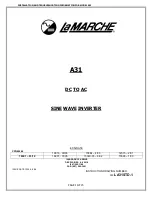
7
Local fuel gas codes may vary widely. For that reason, it is recom-
mended that a local gas distributor or installer be consulted when
installing a gaseous fuel supply system.
In the absence of local fuel gas codes and regulations, booklets
published by the National Fire Protection Association (NFPA) may
be used as sources of information.
Gaseous fuel systems should be installed by a licensed plumber
who is experienced in generator installation and is familiar with
local codes and regulations.
When installing rigid natural gas lines, always use AGA approved
black pipe.
In most applications, a manual shutoff valve and a primary regula-
tor must be a part of the installation (Figure 1.7).
Figure 1.7 — Manual Shutoff Valve
A section of UL or AGA approved flexible fuel line is required to
protect the rigid fuel line connections against vibration from the
generator.
Installing the flexible fuel line with as few bends as possible will
allow the flexible section to absorb and mitigate vibration. Never
use a flexible fuel line to avoid an elbow in a rigid line and never
attach gaseous fuel line supports to any part of the generator.
Doing so defeats the purpose of the flexible fuel line (Figure 1.8).
Figure 1.8 — Flexible Fuel Line
After checking all connections for leaks, check the static gas
pressure at the secondary regulator to ensure there is sufficient
pressure to operate the generator (see Owner’s Manual).
If the static pressure is too low, or is higher than 14 inches of water
column, notify the local gas supplier. (Figure 1.9)
Figure 1.9 — Water Column
1.8.3
PROPERTIES OF GASEOUS FUELS
Natural Gas
Natural gas is lighter than air. It is found in the gaseous state at
normal ambient temperatures and pressures. It is highly explosive
and can be ignited at the slightest spark. For that reason, fuel
lines must be free of leaks and adequate ventilation is absolutely
essential.
Local fuel/gas codes usually dictate the maximum pressure at
which natural gas can enter a structure. In order to reduce the
gas pressure to that required by law, a PRIMARY REGULATOR is
required.
LP Gas
Liquefied petroleum (LP) gas is heavier than air. The gas vapors
are explosive and, like natural gas, can be ignited by the slightest
spark.
LP tank pressure is dependent on the ambient temperature and can
be as high as 200 psi. A primary regulator is required at the tank to
reduce the pressure to the required five to 14 inches of water col-
umn for units less than 70kW, or 11 to 14 inches of water column
for units 70kW and larger.
General Information
Содержание Stationary Emergency Generator
Страница 21: ...19 Operation Figure 3 6 Nexus to RTS Nexus Smart Switch Drawing 0H7453 C ...
Страница 24: ...Part No 0H8218 Revision F 05 08 12 Printed in U S A ...
Страница 25: ......
Страница 26: ......










































